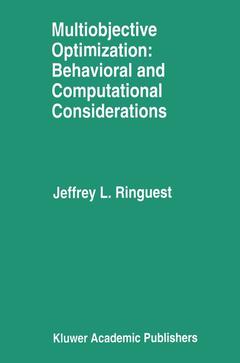Description
Multiobjective Optimization: Behavioral and Computational Considerations, Softcover reprint of the original 1st ed. 1992
Author: Ringuest Jeffrey L.
Language: English
Approximative price 52.74 €
In Print (Delivery period: 15 days).
Add to cart
Publication date: 10-2012
169 p. · 15.2x22.9 cm · Paperback
169 p. · 15.2x22.9 cm · Paperback
Description
/li>Contents
/li>
Throughout the development of mathematical programming researchers have paid great attention to problems that are described by a single objective that can only be achieved subject to satisfying a set of restrictions or constraints. Recently, it has been recognized that the use of a single objective limits the applicability of In reality, many multiobjective mathematical programming models. situations exist and frequently these mUltiple objectives are in direct conflict. Research on multiobjective problems can be broken down into two broad categories: multiobjective optimization and multicriterion decision theory. Multiobjective optimization models are based on techniques such as linear programming. In general, the multiobjective optimization problem can be defined as finding a feasible alternative that yields the most preferred set of values for the objective functions. This problem differs from a single objective because subjective methods are required to determine which alternative is most preferred. A body of literature parallel to that m multiobjective optimization has been developing in the area of multicriterion decision theory. These models are based on classical decision analysis, particularly utility theory. One focus of this research has been the development and testing of procedures for estimating multiattribute utility functions that are consistent with rational decision maker behavior. A utility function provides a model of a decision maker's choice among alternatives. This literature is directly xii MULTIOBJECTIVE OPTIMIZATION applicable to multiobjective optimization and provides much needed insight into the subjective character of that problem.
1. Introduction.- 1.1 Multiple-Objective Optimization.- 1.2 Dominance And Efficiency.- 1.3 Multiattribute Value And Utility Theory.- 1.4 Functional Forms And Independence Conditions.- 1.5 Value Functions As Compared To Utility Functions.- 1.6 Optimizing The Multiattribute Utility Or Value Function.- 1.7 References.- 1.8 Other Relevant Readings.- 2. Linear Goal Programming.- 2.1 The Goal Programming Model.- 2.2 Aspiration Levels.- 2.3 Weights.- 2.4 Preemptive Priorities.- 2.5 Multiattribute Value Theory.- 2.6 Specifying The Weights In An Additive Value Function.- 2.7 Sensitivity Analysis.- 2.8 References.- 2.9 Other Relevant Readings.- 3. Generalizing Goal Programming.- 3.1 Linear Goal Programming.- 3.2 Piecewise Linear Approximations Of Single Attribute Value Functions.- 3.3 Goal Programming With A Multiplicative Value Function.- 3.4 Nonlinear Goal Programming.- 3.5 References.- 4. Compromise Programming.- 4.1 Ideal Solutions.- 4.2 Compromise Functions.- 4.3 Compromise Solutions And The Compromise Set.- 4.4 The Anti-Ideal And Compromise Programming.- 4.5 The Method Of The Displaced Ideal.- 4.6 Compromise Programming, Linear Goal Programming, And Multiattribute Value Functions.- 4.7 References.- 5. Decision Making and the Efficient Set.- 5.1 The Efficient Set.- 5.2 Intra-Set Point Generation.- 5.3 Filtering.- 5.4 Clustering.- 5.5 Matching And Grouping.- 5.6 Sectioning.- 5.7 A Stochastic Screening Approach.- 5.8 References.- 5.9 Other Relevant Readings.- 6. Interactive Methods.- 6.1 The General Interactive Approach.- 6.2 Examples Of Interactive Methods.- 6.3 Simplified Interactive Multiple Objective Linear Programming (SIMOLP).- 6.4 Interactive Multiobjective Complex Search.- 6.5 Choosing An Interactive Method.- 6.6 References.- 7. Computational Efficiency and Problems with Special Structure.- 7.1 Network Flow Problems.- 7.2 Multiple Objective Network Flow ProbLems.- 7.3 A Network Specialization Of A Multiobjective Simplex Algorithm.- 7.4 Compromise Solutions For The Multiobjective Network Flow Problem.- 7.5 Interactive Methods For The Multiobjective Network Flow Problem.- 7.6 References.- 8. Computational Efficiency and Linear Problems of General Structure.- 8.1 Computational Efficiency And The Ideal Solution.- 8.2 Test Problems.- 8.3 Computer Codes.- 8.4 Results.- 8.5 Other Computational Studies.- 8.6 References.- 9. Using Multiobjective Linear Programming to Reconcile Preferences Over Time.- 9.1 Preferences Over Time.- 9.2 The Behavioral Properties Of NPV.- 9.3 A More General NPV Model.- 9.4 Using Multiobjective Linear Programming As An Alternative To NPV.- 9.5 The Advantages Of Using Multiobjective Linear Programming For Reconciling Preferences Over Time.- 9.6 References.- 10. Data Presentation and Multiobjective Optimization.- 10.1 Data Representation And The Axioms Of Utility Theory.- 10.2 The Framing Of Decisions.- 10.3 Reconciling The Decision Frame.- 10.4 Perception Of The Ideal.- 10.5 References.
© 2024 LAVOISIER S.A.S.




